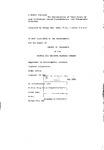The Determination of Trace Metals by High Performance Liquid Chromatography with Photometric Detection
| dc.contributor.author | Hobbs, Philip John | |
| dc.contributor.other | School of Geography, Earth and Environmental Sciences | en_US |
| dc.date.accessioned | 2013-10-08T08:30:44Z | |
| dc.date.available | 2013-10-08T08:30:44Z | |
| dc.date.issued | 1985 | |
| dc.identifier | NOT AVAILABLE | en_US |
| dc.identifier.uri | http://hdl.handle.net/10026.1/2069 | |
| dc.description.abstract |
The importance of trace metals and their species is reviewed and it is recognised that improved methods of determination are required. High performance liquid chromatography has grown in importance as a technique, especially since the synthesis of better column packings. The adaptability of reverse phase and ion chromatography with new post-column reagents for photometric detection for the determination of transition metal cations, is discussed. Separation of divalent transition metal by high performance chromatography was improved by eluents used in column ion chromatography, new eluents were also assessed. Lactate eluents were particularly effective and tartrate, oxalate and thiomalic buffers also showed promise. Two photometric reagents, dithizone and eriochrome black T were used as post-column reagents, sensitivity and calibration characteristics are determined. A novel method of photometric detection, observes the decrease in absorbance of the metallochromic indicator used. Using lactate eluent with the Eriochrome Black T post-column detector, linear calibrations from 10 µg ml to 5 ng mlˉ¹ for cadmium, cobalt, copper, indium, iron (III), iron (II), lead, magnesium, manganese, nickel and zinc were achieved with limits of detection between 0.5 and 5 ng. The dithizone post-column realtor achieved quantitative analysis from 10 ng ml to 10 µg mlˉ¹ for cadmium, cobalt, copper, indium, lead, nickel and zinc with limits of detection for the lactate eluent between 1 and 8 ng except for lead(45 ng). Applications of the eriochrome black T detector are shown for the speciation of iron and the determination of transition metals in river water and the analysis of alloys. The separation of oxyanions is discussed with detection by a pyrocatechol violet ternary complex. The possibility of fluorescent metal detection with 8-hydroxyquinoline-5-sulphonic acid and photometric detection with a water soluble derivative of dithizone is shown. | en_US |
| dc.description.sponsorship | British Drug House Chemicals Ltd, Broom Road, Poole, Dorset BH12 4NN | en_US |
| dc.language.iso | en | en_US |
| dc.publisher | University of Plymouth | en_US |
| dc.title | The Determination of Trace Metals by High Performance Liquid Chromatography with Photometric Detection | en_US |
| dc.type | Thesis | |
| plymouth.version | Full version | en_US |
| dc.identifier.doi | http://dx.doi.org/10.24382/4948 | |
| dc.identifier.doi | http://dx.doi.org/10.24382/4948 |
Files in this item
This item appears in the following Collection(s)
-
01 Research Theses Main Collection
Research Theses Main


